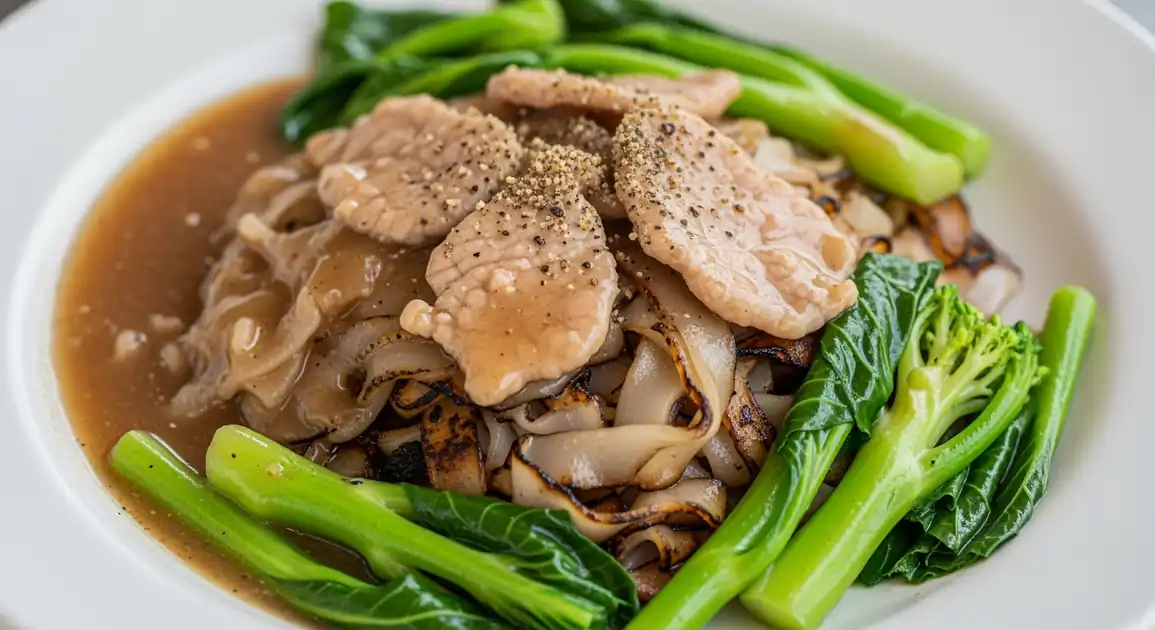Gravy Noodles (Rad Na)
ราดหน้า

Description
Bangkok offers an overwhelming variety of Rad Na options, from legendary street food stalls operating for decades to modern interpretations in cafes. Key areas like Yaowarat (Chinatown) and older neighborhoods boast famous Rad Na vendors. Competition ensures a generally high standard, focusing on 'wok hei' and quality ingredients.
Dietary Information
Serving information
Serving style
Served hot on a plate with the standard four condiments provided separately. Fork and spoon dining.
Quick facts
Highly variable: Lunch-focused vendors (10 AM - 3 PM), evening/late-night vendors (5 PM - 2 AM). Famous shops may have specific opening days/hours.
Safety Tips
What to Look For
-
Dish cooked fresh to order
Ensures noodles are properly stir-fried and the gravy is heated thoroughly, minimizing risks of bacterial growth in lukewarm food.
-
Served piping hot
High temperature indicates recent cooking and helps ensure food safety.
-
Vibrant, fresh-looking Chinese broccoli (Gai Lan)
Wilted, yellowing, or slimy greens indicate lack of freshness and poor quality.
-
Clean wok and cooking station
General cleanliness suggests better hygiene practices during preparation.
-
High customer turnover
A busy stall usually means ingredients are replenished frequently and food is cooked continuously.
-
Gravy is simmering or freshly prepared
Avoid gravy that looks like it's been sitting out at room temperature for extended periods.
What to avoid
-
Pre-fried noodles sitting in a pile
Noodles lose texture and may not be reheated adequately when the gravy is added.
-
Large batches of lukewarm gravy
Gravy held at improper temperatures can be a breeding ground for bacteria.
-
Wilted, old, or discolored vegetables
Indicates poor ingredient quality and potential spoilage.
-
Dirty condiment containers or utensils
Suggests poor overall hygiene standards which could lead to cross-contamination.
-
Visibly unclean vendor practices (e.g., handling money then food)
Increases the risk of transferring germs to the food.
Price information
Price range
Budget tips
- Street stalls in non-tourist areas offer the best prices (50-70 THB).
- Expect to pay more at famous long-standing shops or in mall food courts (70-100 THB).
- Seafood or 'Mee Krob' versions usually cost more.
- Look for lunch specials near office areas.
Value indicators
- Strong smoky 'wok hei' from high-heat frying.
- Perfectly cooked, tender meat or fresh seafood.
- Crisp, vibrant Chinese broccoli.
- Well-balanced, flavorful gravy (not overly sweet or starchy).
- Famous vendors often have queues, indicating quality/popularity.
Where to Find This Dish
Yaowarat (Chinatown)
Home to several famous Rad Na stalls and restaurants, known for strong wok hei and traditional flavors.
Yaowarat Road, Soi Texas
Evening, Late Night
Sao Ching Cha (Giant Swing Area)
Several acclaimed, long-running Rad Na eateries are located in this historic part of Bangkok.
Giant Swing, Bangkok City Hall
Daytime, Evening
Saphan Kwai / Ari
Popular local neighborhoods with numerous street food options including well-regarded Rad Na vendors.
Saphan Kwai Market, Ari Sois
Evening
Various Marketplaces ('Talad')
Local markets often have stalls selling affordable and authentic Rad Na.
Talad Rot Fai (Train Market), Huai Khwang Night Market
Evening, Night
Vendor Tips
- Famous vendors often specialize and have mastered the wok hei technique.
- Queues can be long at popular spots, especially during peak hours.
- Some legendary places might have slightly higher prices but offer premium ingredients (e.g., specific cuts of pork).
- Don't be afraid to try less famous street stalls – many offer excellent Rad Na.
How to Order
Regional Variations
-
Premium Ingredient Versions
(ราดหน้า สูตรพิเศษ)
Some well-known Bangkok vendors might use specific high-quality pork cuts, larger shrimp, or unique family recipes for their marinade or gravy.
-
Rad Na with Crispy Pork Belly
(ราดหน้าหมูกรอบ)
A less common but delicious variation using crispy pork belly ('Moo Krob') instead of marinated pork slices.
-
Emphasis on 'Wok Hei'
(หอมกระทะ)
Bangkok vendors, especially in Chinatown, often pride themselves on achieving a strong smoky wok flavor ('hom krata'), which is highly sought after.
Cultural context
History
Rad Na has its roots in Chinese cuisine, specifically Teochew cooking, brought to Thailand by immigrants. Over time, it was adapted to local Thai tastes, incorporating ingredients like fish sauce and Thai chilies (in condiments). It evolved into the distinct dish beloved today, commonly found alongside its 'dry' cousin, Pad See Ew, in many eateries.
Local significance
Rad Na is a deeply ingrained part of Bangkok's food culture, enjoyed by locals from all walks of life. Famous Rad Na vendors are often considered culinary landmarks.
Eating customs
- Personalizing the flavor with condiments is expected.
- It's common to order Rad Na alongside other dishes like Pad See Ew or soups in local eateries.